Top Takeaways and Key Concepts
- Build a balanced emergency stash with canned goods, grains, and ready-to-eat foods.
- Include water and essential supplies to support basic survival needs during crises.
- Plan for your household’s needs by considering allergies, preferences, and caloric requirements.
- Store food safely in cool, dry places using airtight containers to prevent spoilage.
- Rotate supplies regularly and track expiration dates using labels or apps to avoid waste.
Summary of This Article
This article explains how to build a practical and stress-free emergency food storage plan. It recommends starting with long-lasting essentials like canned foods, rice, pasta, and nut butters, along with snacks for morale. Readers are reminded to plan meals based on family needs, store food properly using airtight containers, and rotate supplies to maintain freshness. The article encourages staying organized and prepared so emergencies feel manageable rather than overwhelming.
Short Video Version of this Article
We all know that life may be full of surprises. You enjoy your warm cup of coffee for a minute, and then you hear about something crazy going on with the weather. Sometimes it really does feel like it’s from a low-budget sci-fi movie!
Please Note: This post may contain affiliate links. If you click one of them, we may receive a commission at no extra cost to you. As an Amazon Associate, I earn from qualifying purchases.
So, what can we do to prepare for those surprises? It’s a good idea to stock up on food for emergencies. But don’t worry. I’m not saying you should turn your garage into a gigantic bean fort. Let’s come up with a better idea.
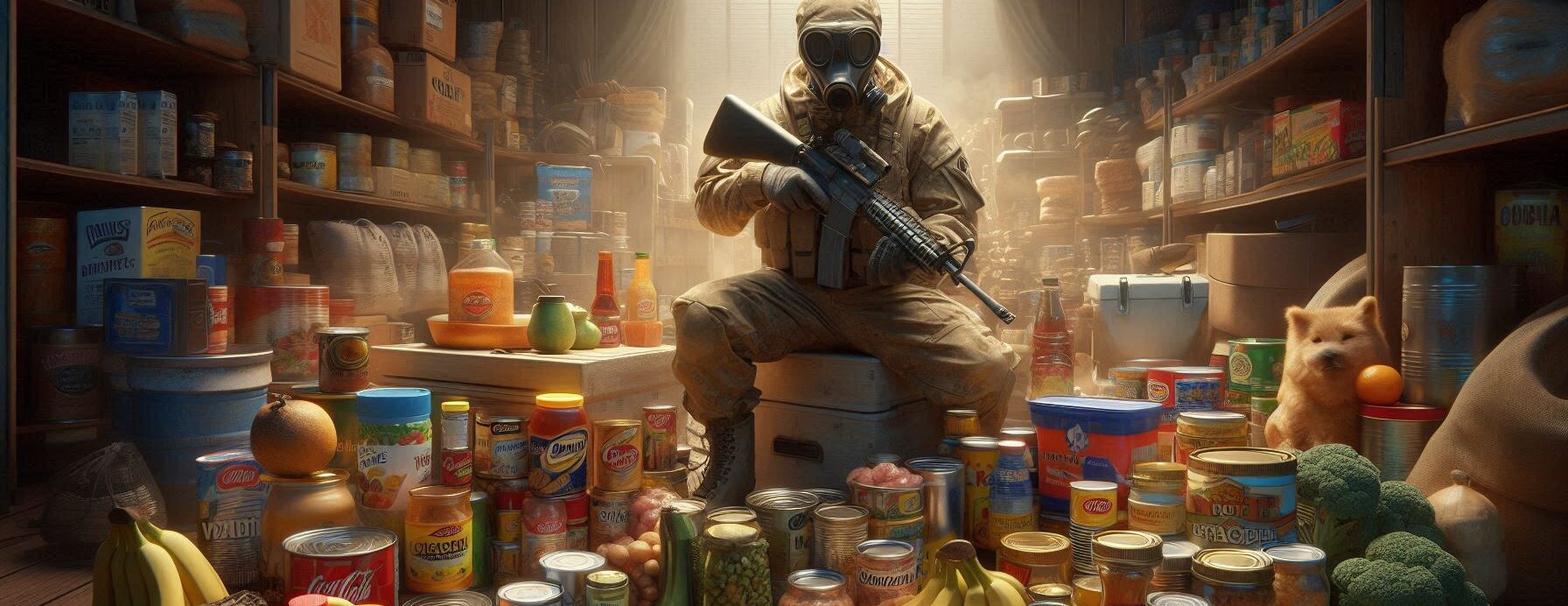
How about building a smart stash? Get some food that will last a while. It’s nice to have canned vegetables, grains, and pasta. You can put them in a lot of different foods. Your stash will be much better if you add additional snacks, such almonds or granola bars.
Don’t forget about water as well. It’s very crucial. Filling a few bottles can save your life. Just think about how ready you’ll be when the weather gets bad. You won’t have to worry about what to eat while everyone else is in a hurry.
Putting this hoard together is like making your own superhero kit. You are getting ready for anything that might happen. Does it feel good? We can get through those surprise days together, and maybe even have fun doing it!
Understanding Your Needs

Before diving headfirst into an avalanche of instant noodles and freeze-dried lasagna (which is somehow both amazing and terrifying), it’s crucial to understand your family’s dietary needs.
Are there picky eaters in your household? You know who they are—the ones who would rather starve than touch anything green. Or maybe someone has food allergies that could turn a simple snack into a hazardous affair.
Oh, and here’s something to think about. When you’re planning how much food to have handy, remember the number of people you’re feeding and how long you might need it. A good idea is to gather enough for at least three days for each person. But if you’ve got teenagers? Oh boy! You might want to double that. Seriously, it’s like they’re snack tornadoes!
Variety matters a lot, too. No one wants to live on just canned peas forever. That’d be so boring. Let’s mix it up a little! Throw in some pasta, canned fruits, and even some rice. Maybe add a few easy-to-cook meals. That way, you can whip up something different every day.
Comfort foods are a must, too. Survival is super important, sure, but what about keeping spirits high? Having a box of cookies or some chocolate bars tucked away can really help. Imagine being in a tough situation but munching on a sweet treat. It makes everything feel a little brighter, right?
So let’s make our food stash fun and useful! We can do this together! Who knew prepping could be such a cozy little adventure?
Choosing What to Stockpile

Now for the fun part—shopping for your emergency stash! It’s like a little adventure. Think of all the non-perishable goodies. Canned beans, pasta, rice, and even dried fruit. These things are great because they won’t sprout legs and run away after a few weeks sitting on your shelf. They’re here to stay!
You might find some cool options, too. Ever tried freeze-dried meals? They’re marketed as “adventure food,” and honestly, they’re surprisingly tasty. It’s kind of a fun twist. Just imagine sitting down and eating what feels like astronaut food! It sounds silly, but it could be a neat way to enjoy a meal when things get tough.
Don’t forget to toss in some snacks. Things like nuts or granola bars are great. They’re not just tasty; they give you a quick boost of energy. Perfect for those days when you need a pick-me-up.
Shopping for this stuff can actually be fun! You get to think about what you’d enjoy eating, even in tough times. It’s all about making sure you’re ready, but also keeping it tasty. Who knew preparing could be this much fun? Enjoy the hunt!
Here are some essentials I recommend:
1. Canned Goods:
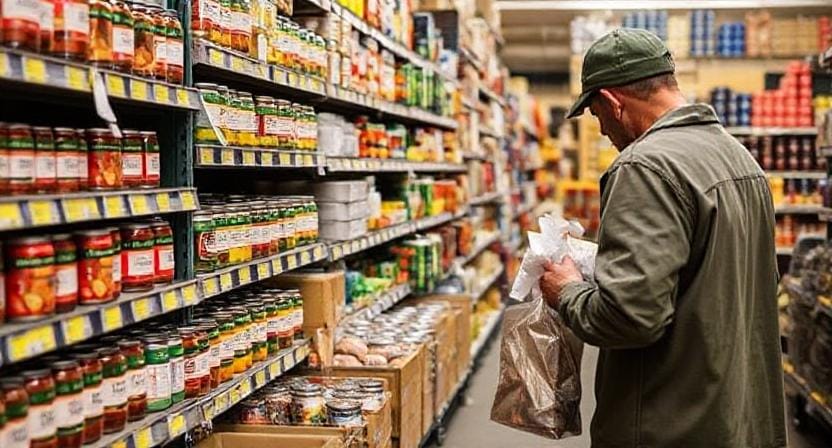
Canned goods are a game changer. Think about beans, veggies, and soups. They’re like little powerpacks in a can! You get protein from beans, which is super important. And fiber? Oh, that keeps everything moving smoothly. So good for your tummy.
When you’re stocking up, look for all kinds of mixes too. Maybe a veggie soup with beans. That’s a warm hug in a bowl when times are tough. Canned veggies are great because you can put them in anything.
It’s nice to know you can just pop open a can when you’re tired or a bit stressed. Quick meals? Yes, please! You don’t always have to cook from scratch. Sometimes, you just need to heat it up and enjoy.
And let’s face it, sometimes those canned soups can feel like comfort food. A little bit of salt, a sprinkle of pepper, and you’ve got a cozy dinner. Who wouldn’t love that? It’s all about being smart but also feeling good. These little goodies can help with both!
2. Grains:
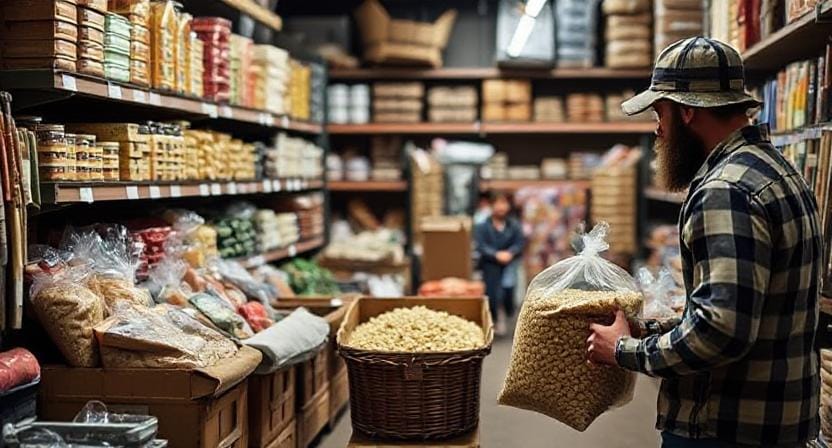
Rice and pasta are lifesavers. They stick around for what feels like forever. You could almost think of them as the superheroes of your pantry! Just picture it—pulling out a bag of rice or a box of pasta when you’re in a pinch. Easy to cook and filling too.
But here’s a little tip. Keep them safe from those annoying pantry bugs. You know, the ones that show up uninvited? Just grab some airtight containers. They work wonders. Your rice and pasta will stay fresh and ready without any bug parties happening.
It’s kind of fun to imagine what you can whip up with these two. A quick stir-fry with rice or some cozy spaghetti with sauce. Those meals can really lift your spirits. Plus, they’re super easy to change up. Toss in some canned veggies or those beans we talked about. Instant meal magic!
Staying prepared can be simple. A little planning goes a long way, and having these staples means you’re ready for whatever comes your way. Panic-free dinners? Yes, please!
3. Nut Butters:
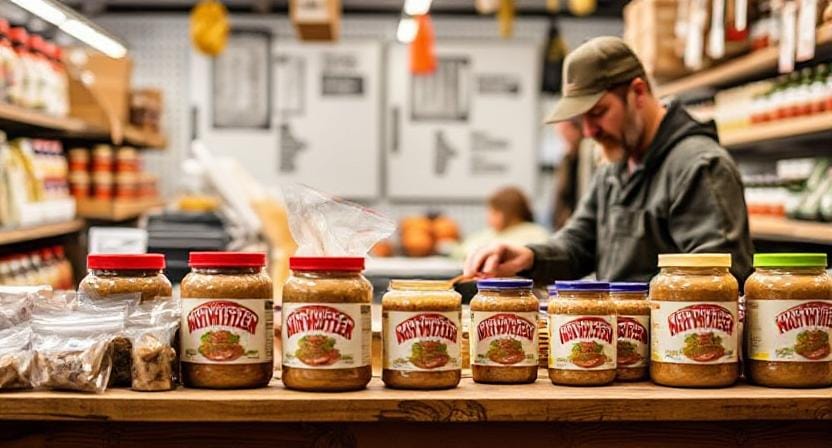
Nut butters are pure gold. Peanut butter, almond butter—both are tasty and super filling. They’re like a warm hug in food form. You can spread them on toast, mix them in smoothies, or just dive in with a spoon. Seriously, spooning peanut butter straight from the jar is a whole vibe.
These butters don’t even need a fridge. Just keep them in your pantry, and they’ll be good for ages. How great is that? Perfect for those busy days when you don’t have time to cook.
They pack a protein punch too. That’s great for when you need a quick pick-me-up. Feeling a bit tired? A swig of almond butter or a scoop of peanut butter can lift your spirits. And you can even add them to oatmeal or yogurt for a little extra yum.
Plus, they can help you feel full longer. That’s a win. Just think about all the yummy snacks you can create. Nut butter and apple slices? Yes, please. It’s like a party for your taste buds. Honestly, having these in your stash makes snacking way more fun. Keep that jar handy!
4. Dried Fruits & Nuts:

Dried fruits and nuts are amazing snacks. They’re like little energy boosters in a bag. Ever had a handful of raisins or apricots? So good. They’re sweet without all the sugar of candy bars. And hey, candy bars have their place too, but these are a healthier option when you want something sweet.
Nuts are fantastic. They crunch just right and keep you full. Almonds, walnuts, or even cashews—there’s so much variety. Throw some in your backpack for a snack later.
Mixing dried fruits with nuts is like a party in your mouth. You get sweet and salty all at once. Perfect for those times when you need a quick pick-me-up. Stalling on a project? A handful of trail mix can help you power through.
Store them in snack-sized bags for easy munching. Easy to grab and go, especially if you’re running out the door.
These snacks also have vitamins and good fats. They help keep your brain sharp. Who doesn’t want that? Just picture it: a busy day, a handful of dried fruits and nuts, and you’re feeling great. It’s like a mini celebration in your pocket!
5. Ready-to-Eat Meals:
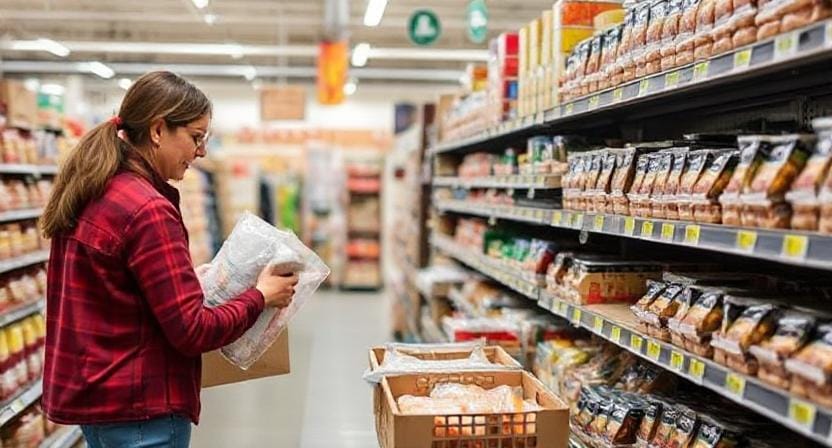
Ready-to-eat meals are super handy. Think about MREs. They’re like meals in a pouch. Just open it up, add some hot water, and voilà! Dinner is served. Perfect for when the power’s out or cooking feels like too much work.
Freeze-dried meals are cool too. You know, the ones that come in those shiny packets. Just add water, and they puff up like magic. It’s really neat. And honestly? They taste way better than you’d expect.
You don’t have to be a chef to enjoy these. Just boil some water, stir, and let it sit for a bit. Easy peasy! Great for camping or just having in case. Sometimes, you just want a meal without fuss.
Plus, these meals are packed with nutrients. No one wants to survive on snacks alone. Mixing these ready options with your other foods makes for a solid plan. You can feel good about being prepared without breaking a sweat.
Next time you’re at the store, grab a couple of these guys. They might end up being a real lifesaver when things get tricky. It’s kind of comforting to know you’ve got dinner covered, even when life gets chaotic!
Storing Your Food Properly
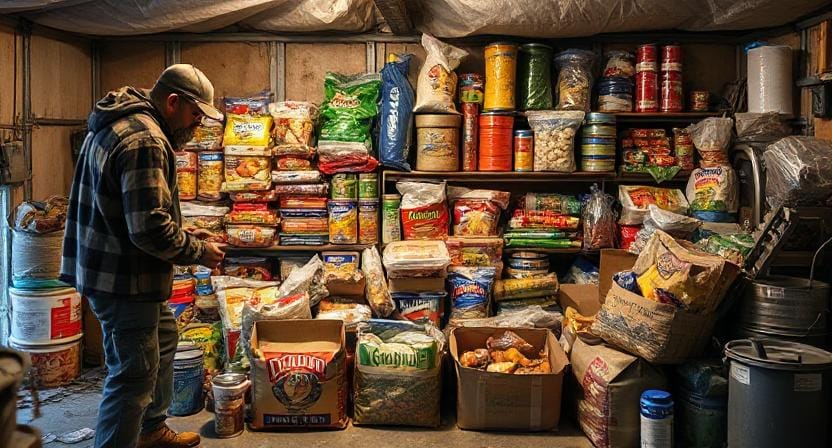
Now that you’ve got all this glorious food ready for action, where do you put it? The garage? Under the bed? In Aunt Edna’s old trunk she insists on keeping “just in case”? Honestly speaking, proper storage makes all the difference between enjoying your hard-earned supplies or discovering a science experiment gone wrong months later.
A cool dry place is ideal—think basement or pantry—but avoid areas prone to temperature fluctuations like attics or garages unless they’re climate-controlled.
Using clear bins is a game changer. It’s so annoying to dig through boxes and not know if you’re holding flour or old snacks. Seriously, no one wants surprise ingredients when things get crazy. Just imagine opening a container and finding something weird. Yikes!
Label those bins. You’ll be so grateful when you can grab what you need in a flash. “Oh, there’s the pasta!” or “Look, my favorite snacks!” It’s like having a treasure map for your food stash.
Rotating your stock is super smart too. Picture this: you find a can from 2008. Not cool, right? Expired tuna salad? Ugh. You don’t want to be that person. Just check your supplies every now and then. Bring the old stuff to the front and put the new stuff in the back. Simple, but it makes a big difference.
Keep it fresh and safe, and you’ll feel more ready for anything. Plus, knowing you’ve got good food will keep your spirits up, even during tough times.
Planning Meals Ahead
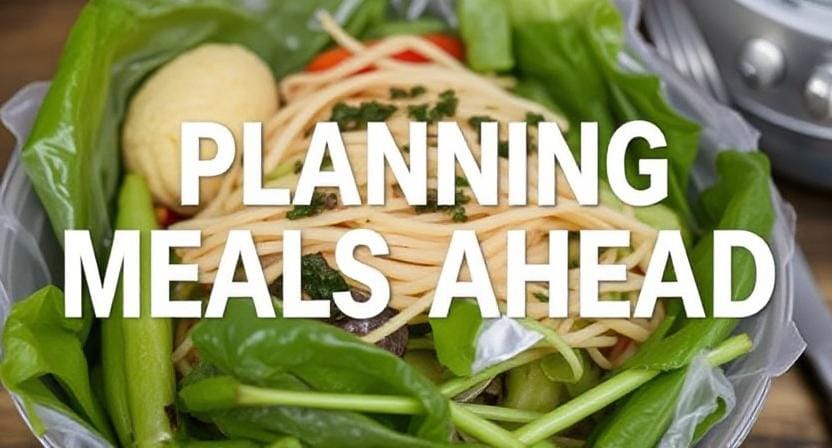
Once you’ve stocked up sufficiently—and ideally not ended up with twenty cans of cream corn—it helps immensely if you plan out meals ahead of time based on what you’ve got stored away.
This isn’t just about being organized; it’ll save precious time during emergencies when stress levels are already high enough without trying figuring out what goes with what!
You know what’s fun? Making simple meals with what you already have. It can be like a little adventure. For example, canned chili over rice? Yum! It’s warm and filling. You could even add a sprinkle of cheese if you have it.
How about pasta? It’s so easy. Just toss it with canned tomatoes and any veggies you find. Voila! Dinner is done. It’s like a hug in a bowl. Simple ingredients can turn into something special.
Nut butter sandwiches are a classic. Spread that peanut butter or almond butter on bread and add some dried fruit. It’s sweet and crunchy. Perfect for lunch or a quick snack.
But let’s be real. When things get stressful, ideas might slip away. You could find yourself staring at the pantry thinking, “What now?” A little planning helps. Having printed recipes handy can save the day. Just grab a sheet, and you’re good to go. It’s like having a friend guiding you through the kitchen.
Being prepared makes everything feel lighter. You can enjoy cooking and eating, even when life’s a bit chaotic. That’s the goal, right? Keep it simple, keep it fun!
Keeping Track of Expiration Dates

Now we arrive at perhaps the most crucial aspect of emergency food storage—expiration dates! Yes folks; even non-perishables have their limits before going full-on science project mode!
Labeling your food can feel a bit like a game, and it really helps. Stick a label on each item with the purchase date. You won’t have to hunt around looking for the oldest can in the back. It might save some time, and trust me, nobody wants a surprise can of soup that’s been hiding for years.
There are cool apps for this too. Yep, apps for everything these days! You can just scan your items and keep track. Super easy. Just a tap, and you know what’s good to go.
If something’s close to expiring in six months? Instead of letting it waste away, think about donating it. Someone else might really appreciate it. Better to share than let it linger.
I get it. I’ve been there. Once, I had a whole drawer filled with expired snacks because I thought, “One day I’ll eat these!” Spoiler alert: I never did. Now that drawer smells like stale chips and regret. Not great.
Keeping things organized helps avoid that smell. You’ll feel better too. It’s all about making your space feel nice and fresh. Plus, you can enjoy what you have! That’s the goal, right? Keep it simple, keep it tasty!
Conclusion
Getting ready for crises doesn’t mean eating boring food while you wait for something bad to happen. No, it’s a lot more fun than that! You may stock up on meals that everyone likes if you prepare beforehand. Think about dishes that are easy to create and taste good.
Smart storage is also helpful. When you keep everything in order, you’ll know exactly what you have. No more cans of food you don’t know what they are or snacks that are over their expiration date at the back of the pantry. No matter what happens outdoors, you can provide meals that everyone will appreciate. It feels wonderful to be ready, whether it’s an ordinary Tuesday or something unexpected.
Imagine this: You have your favorite snacks and meals hidden somewhere. Not only will you feel ready, but it will also make things much easier. You won’t have to worry about what’s for dinner when things become rough.
So, get started on your strategy for storing food in case of an emergency right now. You never know when life will throw you a curveball. Do you have those granola bars and other comfort foods on hand? In my book, that’s a win. It’s all about feeling safe!
Emergency food storage is all about being prepared without panic. A smart emergency pantry includes long-lasting foods, reliable water storage, airtight containers, and simple meal planning. By rotating supplies and understanding your household’s needs, you can stay ready for unexpected situations with confidence and ease.
Frequently Asked Questions
What foods should I include in an emergency food stash?
Choose long-lasting essentials like canned goods, rice, pasta, nut butters, dried fruits, nuts, and ready-to-eat meals so you can build balanced meals quickly during emergencies.
How much emergency food should I store?
Store at least a three-day supply for each person, but a two-week supply is ideal for greater security, especially in households with children or teenagers.
Why is water storage important in emergency planning?
Water is essential for drinking, cooking, and hygiene, so storing clean water ensures survival when the regular supply is disrupted.
Where should I store emergency food supplies?
Store food in a cool, dry location such as a pantry or basement, and avoid areas exposed to extreme temperatures like attics or garages.
How do I keep my emergency food fresh?
Use airtight containers to protect food from pests and moisture, and rotate items regularly using the first-in, first-out method.
What types of meals can I make during an emergency?
Simple meals like pasta with canned sauce, rice with beans, nut butter sandwiches, or ready-to-eat meals help maintain comfort and energy during stressful times.
How do I manage expiration dates in my food storage?
Label items with purchase dates, review your storage monthly, and use apps or lists to track expiration dates and prevent waste.
Suggested Resources:
Emergency Food Storage Tips
https://www.ready.gov/food-storage
How Long Does Food Last During Emergencies?
https://www.foodsafety.gov/keep-food-safe/emergency-preparedness
Best Foods for Long-Term Storage
https://www.preparednessmama.com/best-foods-long-term-storage/

Kevin Collier is a seasoned outdoor enthusiast and writer for Trekbug.com, specializing in outdoor adventures, survival strategies, and prepping insights. With a deep love for nature and a commitment to self-sufficiency, Kevin empowers readers to embrace the wilderness confidently. He shares valuable tips, practical techniques, and inspiring stories, helping both novice and experienced adventurers develop essential skills for surviving and thriving in the great outdoors.





